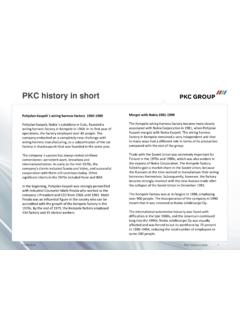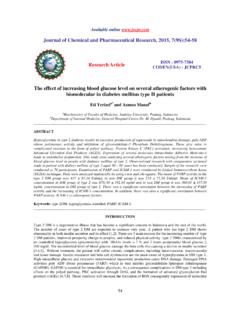Transcription of How Insulin Works - MedBio
1 How Insulin Works Insulin 's metabolic actions. A basic requirement for all vertebrates is stability of the level of blood glucose. This is essential for brain function. Regardless of large fluctuations in physical activity and food intake, blood sugar levels are held within very narrow limits. The key to this is Insulin , the secretion of which is closely regulated by circulating substrates of energy metabolism. Insulin signals food abundance and initiates uptake and storage of carbohydrates, fats and amino acids. Energy supply and stability of blood sugar levels postprandial is usually accorded to glucagon and the catecholamines, but the reduction in Insulin signalling postprandial is almost certainly just as important. How does Insulin influence our metabolism?
2 What are the key events in its action? 1. A brief summary of effects on key metabolic pathways and enzymes. Control of the key enzymes of metabolism can be divided into two classes: 1. Covalent modification of enzymes, usually by phosphorylation or dephosphorylation of serine, threonine or tyrosine residues. 2. Allosteric feedback and feed-forward regulation by metabolic intermediates. Enzymes involved in metabolism can be either activated or inactivated by phosphorylation. Examples or this are glycogen phosphorylase and hormone-sensitive lipase which are activated when phosphorylated and glycogen synthetase and pyruvate dehydrogenase are inactivated through phosphorylation. The protein kinases that catalyze phosphorylation of these enzymes are subject to control through cyclic nucleotides (PKA and cyclic AMP), Ca++ and diacylglycerol (PKC) and PI(3,4,5P)P3 (PKB).
3 The extent of enzyme phosphorylation is controlled by the balance between protein kinases and protein phosphatases. The picture becomes extremely complex when one knows that protein kinases can activate protein phosphatases. This is clearly the case for the Insulin -activation of pyruvate dehydrogenase and, therefore, crucial in Insulin 's stimulation of hepatic lipid synthesis. Hormone-sensitive lipase activity in fat cells is regulated largely through cAMP activation of protein kinase A (PKA). The cyclic nucleotide levels is controlled through the balance between hormone-regulated G-protein control of adenylate cyclase and breakdown of cAMP catalyzed by phosphodiesterase. Insulin regulates cAMP levels through its stimulatory effect on the esterase and reduction of cAMP levels.
4 Insulin and Opposing Hormones control Metabolism 1. Insulin is an anabolic hormone, causing cells to take up energy substrates at times of excess. Insulin action is countered by the catabolic hormones glucagon, adrenalin and noradrenalin, and growth hormone. These act primarily through cyclic AMP (cAMP) and protein kinase A. Look at the figure below. This is merely a rough sketch over the mechanisms involved in control of metabolic hormones. Insulin 's actions are far more complex than control of enzyme phosphorylation. However, as a generalization, one can say that the catabolic hormones work through activation of protein kinase A. with ensuing phosphorylation of key enzymes. Insulin activates protein phosphatases and dephosphorylates these enzymes. Some of these are activated by phosphorylation, other are inactivated through the same mechanism.
5 Insulin activates glycogen synthetase and pyruvate dehydrogenase, and inactivates phosphofructokinase II and hormone-sensitive lipase. Complicated control mechanism steer hormone secretion such that metabolism is constantly adjusted by hormones to meet our widely varying energy intake and expenditure, assuring a constant internal milieu. Diabetes What happens when Insulin production and secretion fails? How does the body react to a collapse of the Insulin signalling system? This can follow either destruction of Islet beta cells (diabetes type 1) or loss of response to Insulin (diabetes type 2/ Insulin resistance). Several other forms of diabetes are known. The next diagram depicts the metabolic result of loss of the Insulin system. Glucose uptake to muscle and fat cells is dependent upon activation of GLUT4 by Insulin .
6 This system fails when Insulin secretion or when the body's responsiveness is no longer coupled to blood glucose levels. The liver's gluconeogenesis progresses without alteration following reduction or loss of the Insulin signal, releasing sugar in spite of high blood glucose levels. The body reacts as though glucose was not present. Lipolysis and hepatic gluconeogenesis are activated by glucagon, growth hormone and catecholamines to meet this low energy crisis . Massive amounts of fatty acids are released to the 2. circulation and the liver converts these to ketone bodies. The high blood glucose levels lead to diuresis with loss of water, Na+, K+ and glucose, while the ketones (which are actually carboxy acids) lead to a pronounced fall in blood pH. Diabetic coma and death follow if effective treatment is not initiated.
7 The Insulin Signaling System How does the Insulin receptor work ? Insulin was the first of our hormones to be isolated and identified. Banting and Best purified Insulin in 1922 and treated a diabetic patient with Insulin that year. One might have expected that an understanding of the mechanism of action of Insulin would quickly follow. Surprisingly, Insulin 's mechanism of action is exceedingly complex and is still not completely known. We can our discussion begin by looking at a few cartoons from the 1980's. By that time the Insulin receptor had been identified and its movements in the target cell's plasma membrane had been noted. Insulin combined with a protein- receptor molecule, moved into clathrin- coated pits which then disappeared into the cell's interior.
8 These Insulin -carriers were thought to wind up in lysosomes and to be destroyed there. Later it was established that some of the "ingested" receptors were actually recovered, repaired in the Golgi apparatus and reappeared as active receptors in the cell's plasma membrane. This was really exciting at that time, and many of us went to work to find out what happened when the hormone bound to its receptor. We were looking for a "simple" signal substance that went from the activated hormone-receptor complex into the cell and which started up all of those mystical actions of Insulin . This was the pattern we were accustomed to see with several other hormones. 3. The situation was summarized in another beautiful cartoon by "Chuck", published in TIBS. We were just lacking that single second messenger for Insulin that could carry out all of the complex actions the hormone had.
9 4. Well, soon afterward it became clear that one of the very first things that happened after hormone binding was initiation of autophosphorylation reactions, whereby the intracellular parts of the receptor became tyrosine-phosphorylated by the protein kinase activity of these same receptors. A phosphorylation cascade followed and started up a whole series of enzyme phosphorylation/. dephosphorylati on reactions which are now thought to account for the effects of Insulin . Insulin 's actions are summarized in the next figure. The active receptor speeds uptake of amino acids and glucose, activates protein synthesis from amino acids and glycogen and triglyceride synthesis from glucose. Insulin inhibits breakdown of triglycerides in adipose tissue and gluconeogenesis in the liver.
10 A. whole series of intracellular signal substances seemed to be responsible for the many actions of Insulin . 5. These are shown in the next figure from the work of Saltiel and Kahn. Here we can see that the phosphorylation of the Insulin receptor starts up serine- threonine phosphorylation of a series of proteins, the so- called Insulin - receptor substrates (IRS1- 4). These are coupled to several additional protein kinase signal systems: 1. Pathways signaling through PI 3-kinase and phosphatidylinositol (3,4,5)P3 (PI-3 kinase and protein kinase B/Akt). 2. Mitogen-activated protein kinases (MAPK inases). NB: Both group 1and 2 signals also activate protein kinase C and Protein kinase C . 3. Possible interaction via kinases not coupled to IRS proteins. It has been suggested that the most dominant is the first group (PI 3-kinase) which converts phosphatidylinositol 3,4 bisphosphate (PIP2) or [PI(3,4)P2] to phosphatidylinositol 3,4,5 triphosphate PIP3 or (PI 3,4,5)P3.









